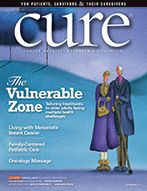Publication
Article
CURE
Dense Breasts Alone May Not Warrant Follow-Up Imaging After Screening Mammogram
Author(s):
The fact that dense breast tissue can make cancers difficult to see via mammogram has been the subject of numerous recent news reports.
The fact that dense breast tissue can make cancers difficult to see via mammogram has been the subject of numerous recent news reports.
Last year, TV personality Joan Lunden disclosed that her own dense tissue masked tumors in her breasts, which were identified via a follow-up ultrasound after mammogram. In fact, in 24 states, doctors must inform women if a screening mammogram shows they have dense breast tissue; then, despite a normal mammogram result, these doctors and patients can discuss whether ultrasound or other follow-up imaging, such as MRI or PET, might be indicated.
However, according to a recent study, breast density by itself is not enough reason for women to pursue additional imaging after a normal screening mammogram. Other considerations should include how dense the breast tissue is, as well as the woman’s age, race, family history of breast cancer and personal breast biopsy history.
According to the National Cancer Institute (NCI), which helped to fund the study and reported the results on its blog, Cancer Currents, knowing which women are most likely to benefit from additional imaging is important, because, while potentially capable of finding cancers missed by mammograms, these procedures can also increase the chances of false-positive results, leading to additional procedures such as unnecessary biopsies.
“We found that for the vast majority of women undergoing mammography — including those with dense breasts but low five-year breast cancer risk — the chance of developing breast cancer within 12 months of a normal mammogram was low,” the study’s lead investigator, Karla Kerlikowske, of the University of California, San Francisco, said in the NCI blog article.
The study included information about 365,000 women, aged 40 to 74, who were enrolled in breast cancer screening registries. Nearly half the women in the study had dense breasts.
The study found that the women most likely to develop a cancer between mammograms were those whose breasts were 75 percent dense and who faced a five-year breast cancer risk of 1.67 percent or more; also at risk were women with heterogeneously dense breasts — more than 50 percent dense – and a five-year risk of 2.5 percent or more. To calculate five-year risk, study investigators relied on the Breast Cancer Surveillance Consortium’s Risk Calculator, citing it as a good tool for doctors who want to assess risk in their patients; it can be found here. The investigators used the four-category BI-RADS system to classify the women’s level of breast density.
Of the women in the study with dense breasts, 24 percent faced a high risk of a breast cancer developing between mammograms, the investigators reported. They added that women with the highest five-year risk were most likely to have advanced cancer at diagnosis, indicating that they are among those most likely to benefit from follow-up screening after a mammogram.
Based on the study’s results, “It just doesn’t make sense for all women with dense breasts to get additional screening,” Kerlikowske told the NCI.





